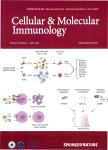NKT cell subsets as key participants in liver physiology and pathology
NKT cell subsets as key participants in liver physiology and pathology作者机构:Department of Medicine University of California San Diego La Jolla CA 92037 USA
出 版 物:《Cellular & Molecular Immunology》 (中国免疫学杂志(英文版))
年 卷 期:2016年第13卷第3期
页 面:337-346页
核心收录:
学科分类:0710[理学-生物学] 1004[医学-公共卫生与预防医学(可授医学、理学学位)] 1002[医学-临床医学] 07[理学] 1001[医学-基础医学(可授医学、理学学位)] 09[农学] 0906[农学-兽医学] 0713[理学-生态学]
基 金:TheNationalInstitutesofHealth USA(R01CA100660 R01AA020864)
主 题:CDld lipids liver disease NKT cells
摘 要:Natural killer T (NKT) cells are innate-like lymphocytes that generally recognize lipid antigens and are enriched in microvascular compartments of the liver. NKT cells can be activated by self- or microbial-lipid antigens and by signaling through toll-like receptors. Following activation, NKT cells rapidly secrete pro-inflammatory or anti- inflammatory cytokines and chemokines, and thereby determine the milieu for subsequent immunity or tolerance. It is becoming clear that two different subsets of NKT cells-type I and type II--have different modes of antigen recognition and have opposing roles in inflammatory liver diseases. Here we focus mainly on the roles of both NKT cell subsets in the maintenance of immune tolerance and inflammatory diseases in liver. Furthermore, how the differential activation of type I and type II NKT cells influences other innate cells and adaptive immune cells to result in important consequences for tissue integrity is discussed. It is crucial that better reagents, including CDld tetramers, be used in clinical studies to define the roles of NKT cells in liver diseases in patients.



